Japanese garden design is a beautiful blend of nature, aesthetics, and tranquility. Rooted in centuries of tradition, these gardens are created to inspire reflection and harmony, using elements like water, rocks, and plants to evoke natural landscapes. Each design decision, from stone placement to tree selection, plays a role in creating a serene escape where every detail invites contemplation.
Creating Balance with Asymmetry
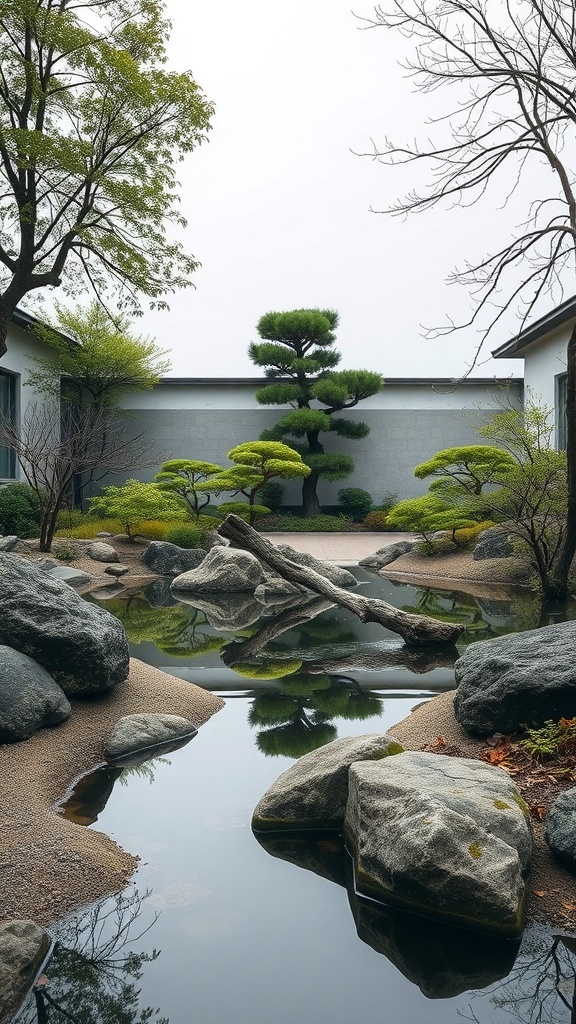
In Japanese garden design, balance is key, and asymmetry plays a big role in achieving it. The image showcases a serene garden with a mix of trees, rocks, and water, creating a natural harmony. Notice how the elements are not arranged in a perfectly symmetrical way. Instead, they are placed to draw the eye and create interest.
The tall pine tree stands proudly, while smaller shrubs and rocks surround it, adding depth to the scene. This arrangement encourages exploration and invites visitors to appreciate the beauty from different angles. The reflection in the water enhances this effect, making the garden feel even more expansive.
Asymmetry in design helps to mimic nature, where nothing is perfectly aligned. This approach allows for a more organic feel, making the space feel alive and inviting. The gentle curves of the path and the placement of stones lead the viewer’s gaze through the garden, creating a sense of flow.
Overall, this garden illustrates how asymmetry can create balance and tranquility, making it a perfect retreat for relaxation and reflection.
Zen Gardens: A Space for Meditation
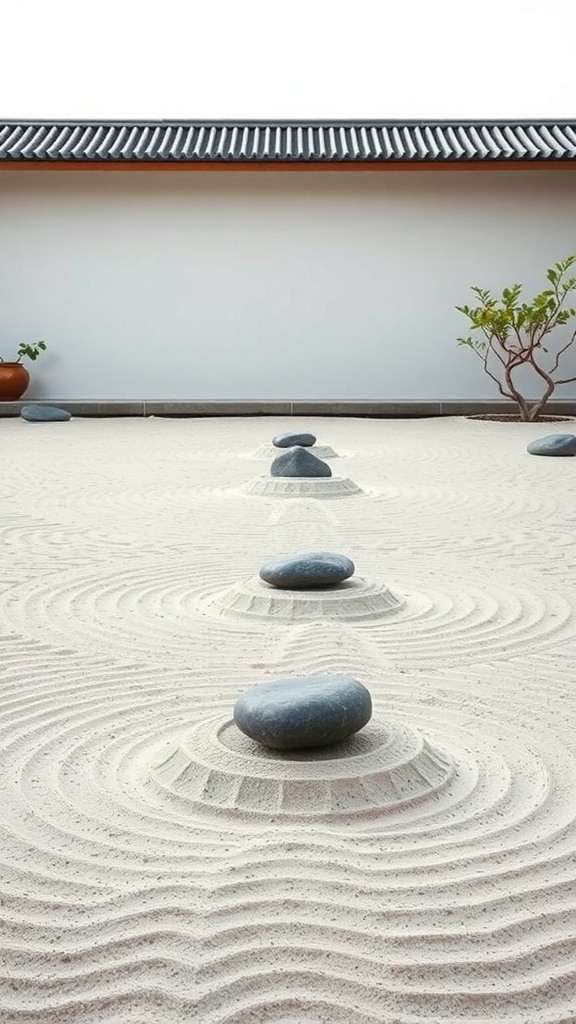
Zen gardens, often known as Japanese rock gardens, offer a serene escape for meditation and reflection. The image showcases a beautifully arranged space, featuring smooth stones placed on meticulously raked sand. This design invites calmness and encourages mindfulness.
The gentle curves in the sand symbolize water ripples, creating a sense of movement and tranquility. Each stone serves as a focal point, drawing the eye and providing a place for contemplation. The simplicity of the elements—sand, stones, and a few plants—highlights the beauty of minimalism.
Incorporating a Zen garden into your space can transform it into a peaceful retreat. Whether you have a large backyard or a small balcony, you can create a miniature version. Just a few stones and some sand can make a world of difference in your daily routine.
Incorporating Water Features for Tranquility
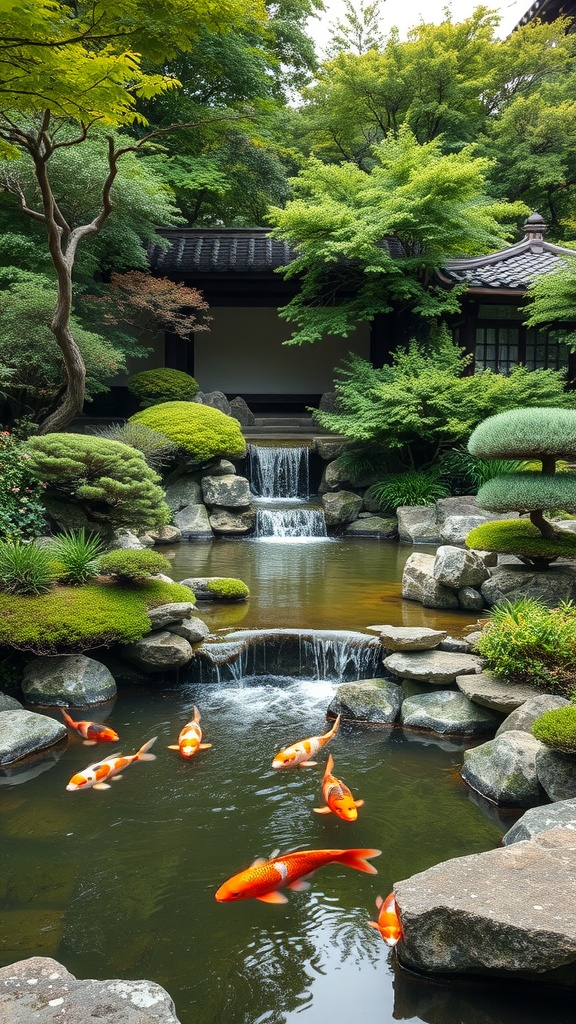
Water features are a key element in Japanese garden design. They bring a sense of calm and serenity to the space. The image showcases a beautiful pond with koi fish swimming gracefully. The gentle flow of water creates a soothing sound that enhances the peaceful atmosphere.
The rocks and greenery surrounding the water add to the natural beauty. The cascading waterfall not only looks stunning but also contributes to the tranquil soundscape. This combination of elements invites visitors to relax and enjoy the moment.
Incorporating a water feature in your garden can transform it into a peaceful retreat. Whether it’s a small pond or a larger stream, the presence of water encourages reflection and mindfulness. It’s a simple way to enhance the overall experience of your garden.
The Role of Stones and Gravel in Japanese Gardens
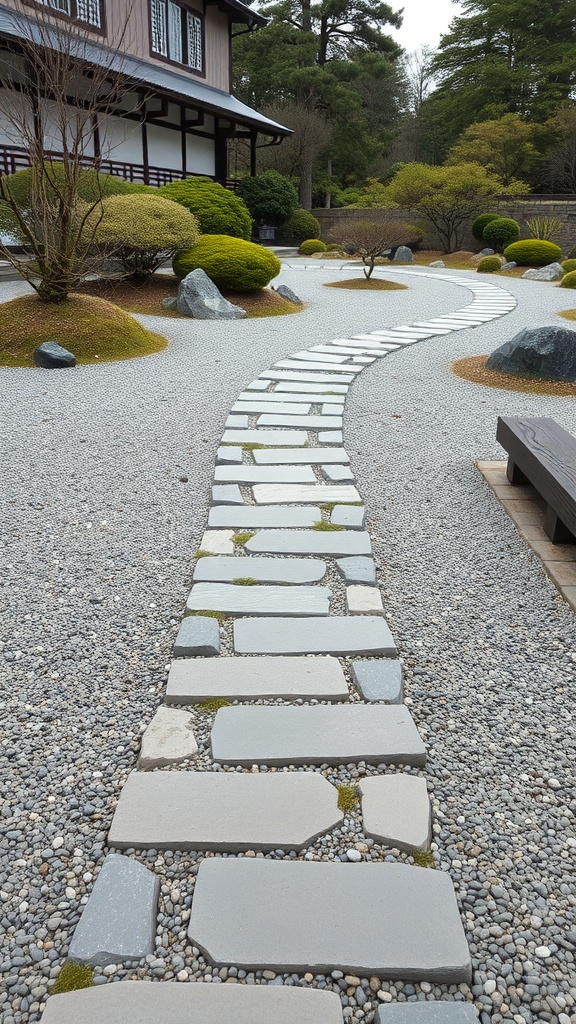
Stones and gravel play a key role in Japanese garden design, creating a sense of tranquility and harmony. In the image, you can see a beautifully arranged path made of flat stones, leading through a gravel area. This design invites visitors to walk slowly and appreciate the surroundings.
The gravel serves multiple purposes. It represents water, creating a serene atmosphere. The texture of the gravel contrasts nicely with the smooth stones, enhancing the visual appeal. The careful placement of rocks and gravel helps define spaces within the garden, guiding the eye and the foot.
In Japanese gardens, stones symbolize permanence and strength. They are often placed strategically to create focal points or to represent mountains. The use of different sizes and shapes adds depth and interest to the landscape.
Overall, stones and gravel are not just functional; they are essential elements that contribute to the beauty and meaning of Japanese gardens. They encourage mindfulness and reflection, making each visit a unique experience.
Tea Garden Design: A Cultural Experience
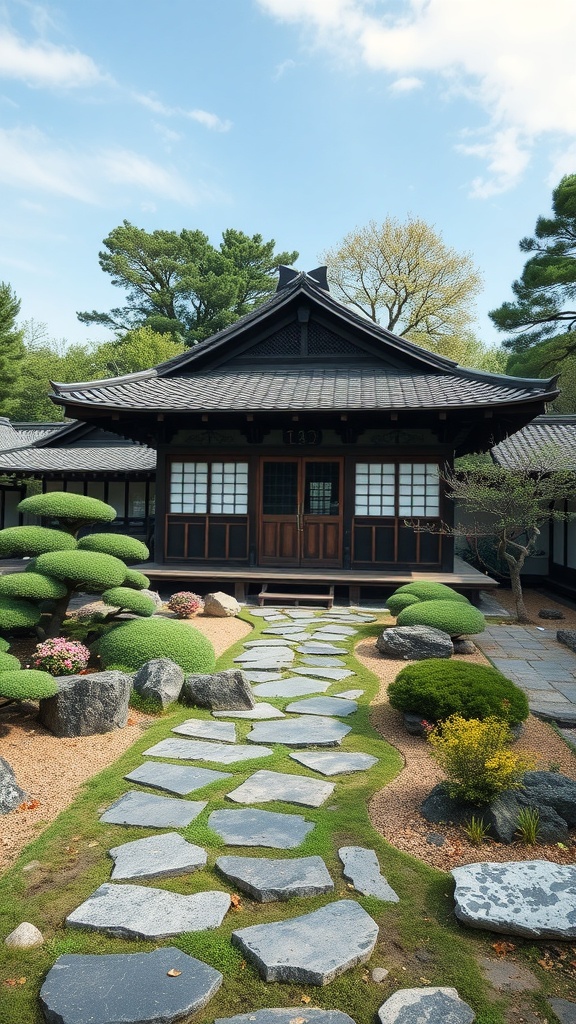
A tea garden is more than just a place to sip tea; it’s a space that invites reflection and connection with nature. The image showcases a serene tea garden, complete with a traditional Japanese tea house. The design emphasizes harmony, balance, and simplicity, which are core principles in Japanese culture.
The winding stone path leads visitors through carefully manicured greenery and rocks, creating a sense of journey. Each element, from the lush bushes to the smooth stones, is thoughtfully placed to enhance the overall experience. This garden is a perfect spot for tea ceremonies, where the beauty of nature complements the ritual of tea.
Incorporating a tea garden into your landscape can bring a slice of tranquility to your home. It encourages mindfulness and offers a peaceful retreat. Whether you’re enjoying a cup alone or sharing it with friends, the calming environment enhances the experience.
Symbolism of Plants in Japanese Garden Design
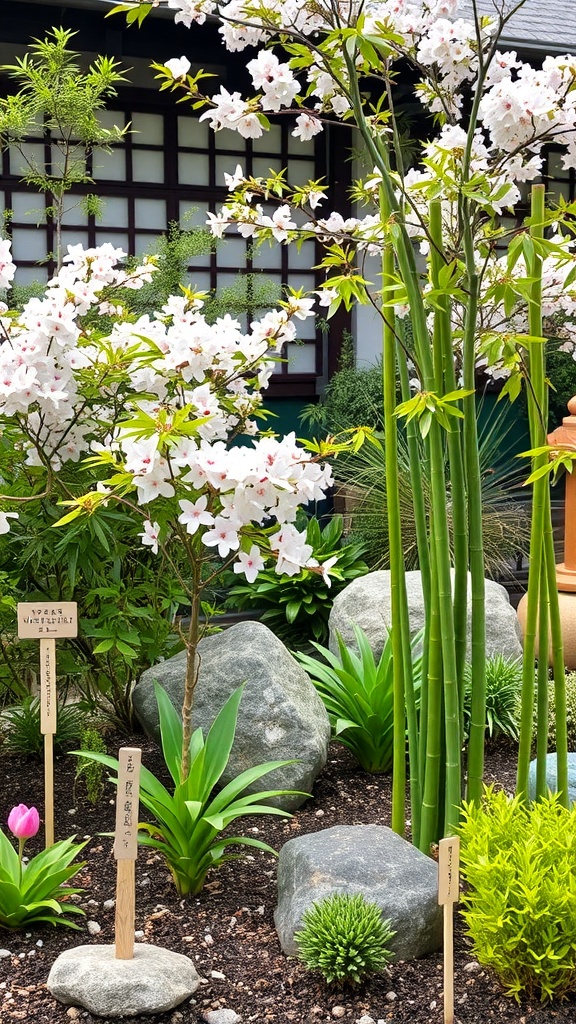
Plants in Japanese gardens carry deep meanings and symbolism. Each type of plant is chosen not just for its beauty but for what it represents. For instance, cherry blossoms symbolize the fleeting nature of life, reminding us to appreciate beauty in the moment.
The bamboo in the image stands tall and strong, symbolizing resilience and flexibility. It’s a favorite in many gardens, often representing strength and the ability to adapt to challenges.
In the foreground, the lush green leaves and vibrant flowers add a touch of life and color. These plants often symbolize renewal and growth, reflecting the changing seasons and the cycle of life.
Rocks and stones, like those seen here, are also significant. They represent permanence and stability, contrasting with the delicate nature of the plants. Together, they create a harmonious balance in the garden.
Overall, every element in a Japanese garden, from the plants to the stones, tells a story. This thoughtful design encourages visitors to reflect on nature and their own lives.
Integrating Pathways for Exploration
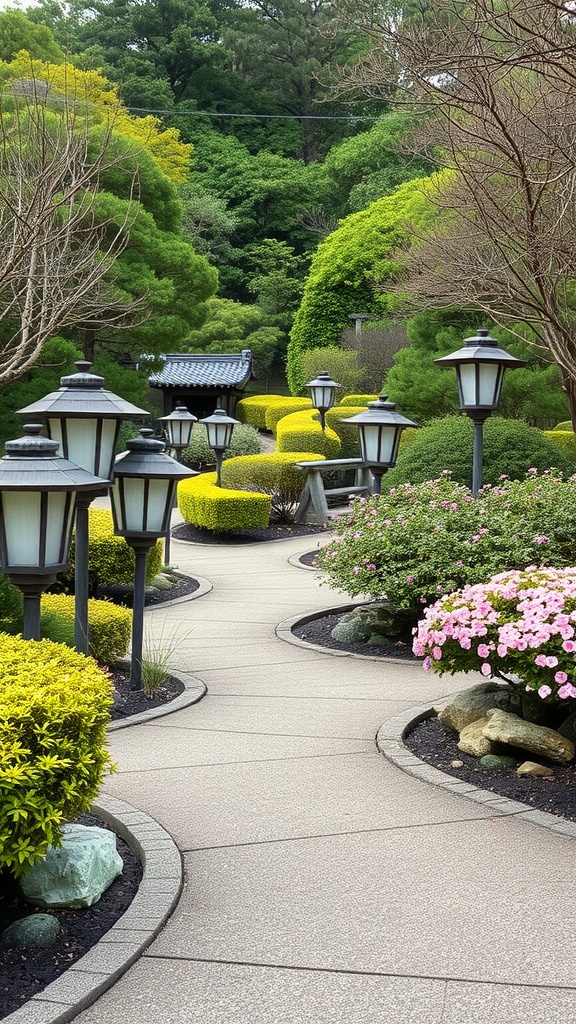
Pathways are key in a Japanese garden. They guide visitors through the landscape, inviting them to take in the beauty around them. The image showcases a winding path lined with charming lanterns and vibrant plants. This design encourages a leisurely stroll, allowing for moments of reflection.
The gentle curves of the pathway create a sense of mystery. Each turn reveals new sights, like colorful flowers and lush greenery. The soft lighting from the lanterns adds a warm touch, making the garden feel welcoming, even in the evening.
Incorporating pathways in your garden design can enhance the overall experience. They not only connect different areas but also create a flow that feels natural. Consider using materials that blend with the surroundings, like stone or gravel, to keep the focus on the plants and features.
Adding benches or resting spots along the way can encourage visitors to pause and enjoy the scenery. This thoughtful integration of pathways transforms a garden into a space for exploration and tranquility.
Principles of Japanese Aesthetics in Garden Design
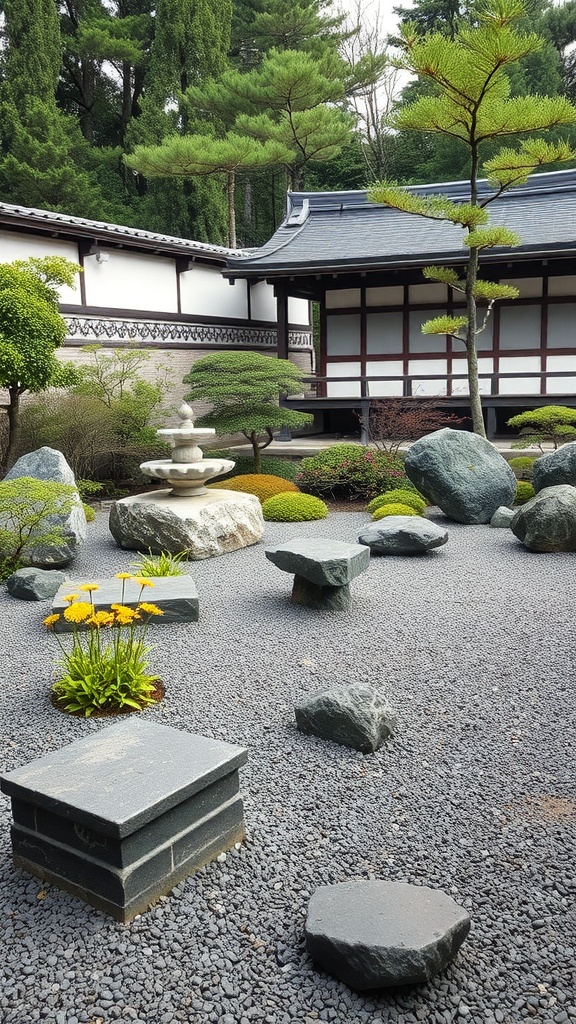
Japanese gardens are a beautiful blend of nature and design, showcasing principles that reflect simplicity and harmony. The image captures a serene garden space, where every element is thoughtfully placed. The use of rocks, gravel, and plants creates a peaceful atmosphere.
In this garden, the arrangement of stones and the gentle curves of the gravel symbolize natural landscapes. The rocks are not just decorative; they represent mountains or islands, adding depth to the design. The greenery, including the carefully trimmed trees, enhances the feeling of tranquility.
The fountain in the center serves as a focal point, drawing the eye and inviting contemplation. Water features are common in Japanese gardens, symbolizing purity and renewal. The overall layout encourages visitors to walk slowly, taking in the beauty around them.
Colors play a significant role too. The subtle greens and earthy tones create a calming palette. Bright flowers, like the yellow blooms in the foreground, add a touch of vibrancy without overwhelming the senses.
Ultimately, this garden exemplifies the Japanese aesthetic of ‘wabi-sabi,’ which finds beauty in imperfection and transience. Each stone, plant, and water feature contributes to a harmonious whole, inviting a moment of reflection and peace.
Cultural Significance of Garden Layouts
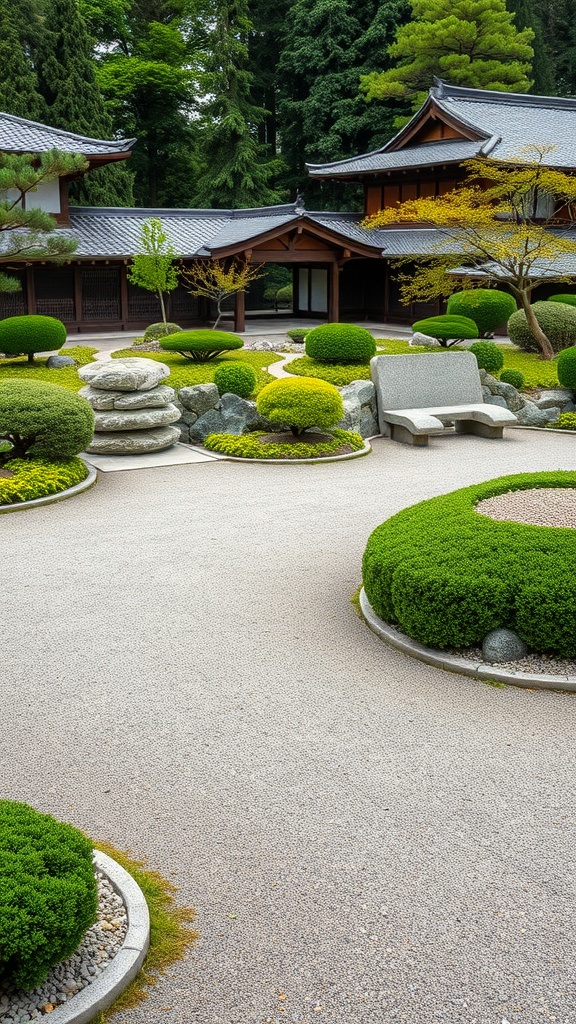
Japanese gardens are not just beautiful; they hold deep cultural meaning. The layout of these gardens reflects harmony and balance, key principles in Japanese aesthetics. The arrangement of stones, plants, and water features creates a sense of tranquility.
In the image, you can see a well-structured garden with carefully shaped shrubs and rocks. Each element has its purpose, symbolizing various aspects of nature. For example, the rocks often represent mountains, while the paths guide visitors through a peaceful journey.
These gardens also serve as a space for reflection and meditation. The design encourages visitors to slow down and appreciate the beauty around them. It’s a reminder of the connection between nature and human life, emphasizing simplicity and mindfulness.
Bonsai Trees: Artistry and Care
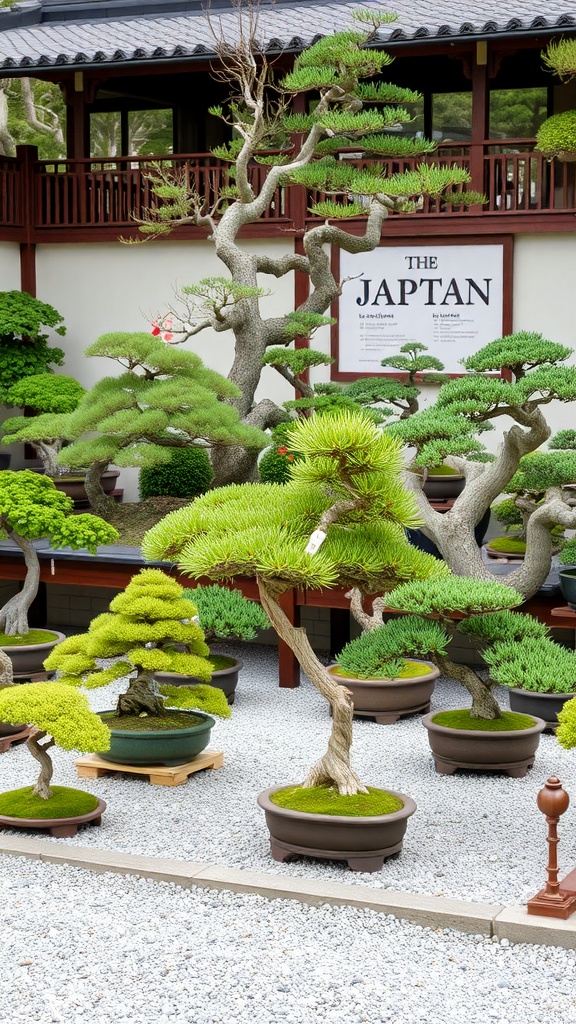
Bonsai trees are a beautiful blend of nature and artistry. The image showcases a variety of bonsai trees, each uniquely shaped and carefully tended. These miniature trees are not just plants; they are living art pieces that require dedication and skill.
The different styles of bonsai reflect the creativity of the gardener. Some trees have twisted trunks, while others boast lush, green foliage. Each bonsai tells a story, representing years of careful pruning and nurturing. The vibrant colors and textures make them a focal point in any garden.
Caring for bonsai involves regular watering, pruning, and repotting. It’s a rewarding process that connects you with nature. Whether you’re a beginner or an experienced gardener, bonsai trees offer a fulfilling way to express your creativity and patience.
Incorporating Wildlife into Garden Design
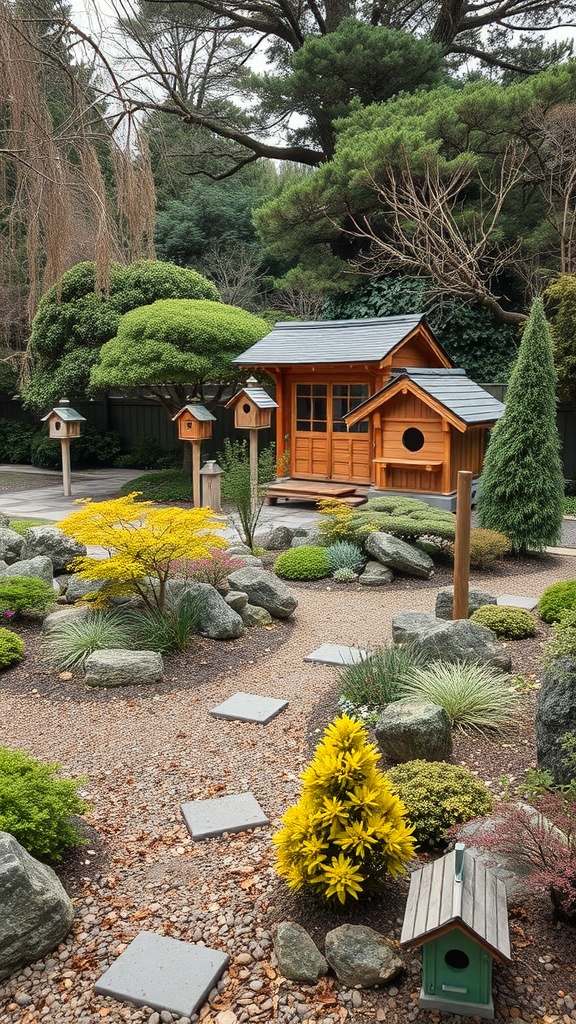
Creating a Japanese garden is not just about aesthetics; it’s also about inviting nature into your space. The image shows a charming garden with a wooden structure and birdhouses, perfect for attracting various wildlife.
Birdhouses are a great addition. They provide safe nesting spots for birds, encouraging them to visit your garden. You can enjoy their songs and vibrant colors throughout the seasons.
Incorporating native plants is another way to attract wildlife. The colorful shrubs and flowers in the garden not only add beauty but also provide food and shelter for local birds and insects.
Water features, like small ponds or fountains, can also draw in wildlife. They offer a drinking source and a habitat for frogs and other creatures. The gentle sound of water enhances the peaceful atmosphere.
Using rocks and stones, as seen in the image, creates natural hiding spots for small animals. This adds to the garden’s charm while supporting local ecosystems.
Using Bridges to Connect Spaces
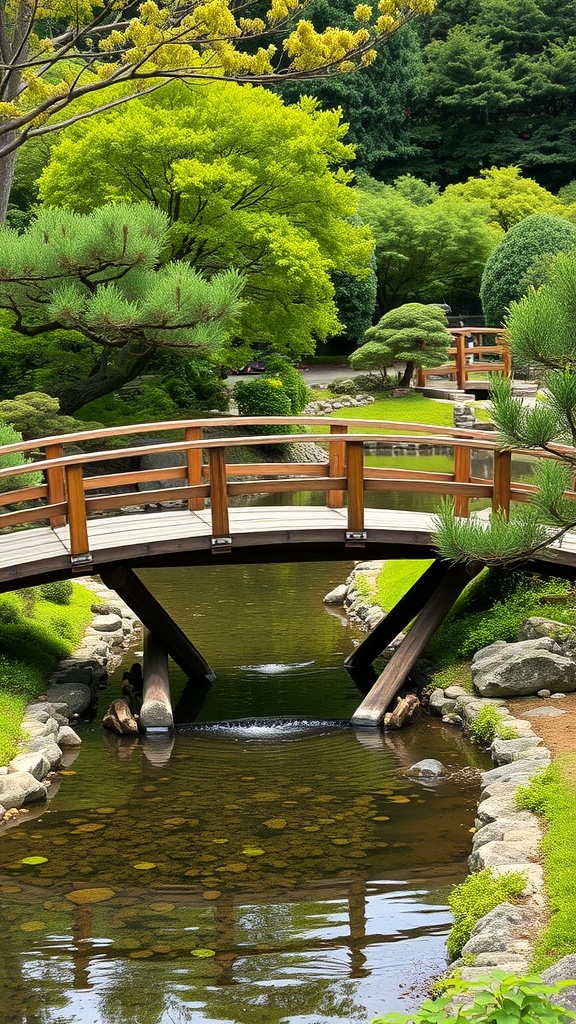
Bridges in Japanese garden design serve more than just a practical purpose. They create a visual and emotional connection between different areas of the garden. This image showcases a beautifully crafted wooden bridge arching over a serene waterway, surrounded by lush greenery.
The bridge invites visitors to cross over, encouraging exploration and interaction with the landscape. It symbolizes a journey, guiding the eye and spirit from one space to another. The gentle curve of the bridge complements the flowing water beneath, enhancing the overall harmony of the scene.
Incorporating a bridge can transform a garden layout, making it feel more expansive. It encourages movement and provides a unique perspective of the surroundings. As you walk across, you can appreciate the carefully arranged plants and the tranquil water, creating a peaceful experience.
Creating Privacy with Natural Barriers
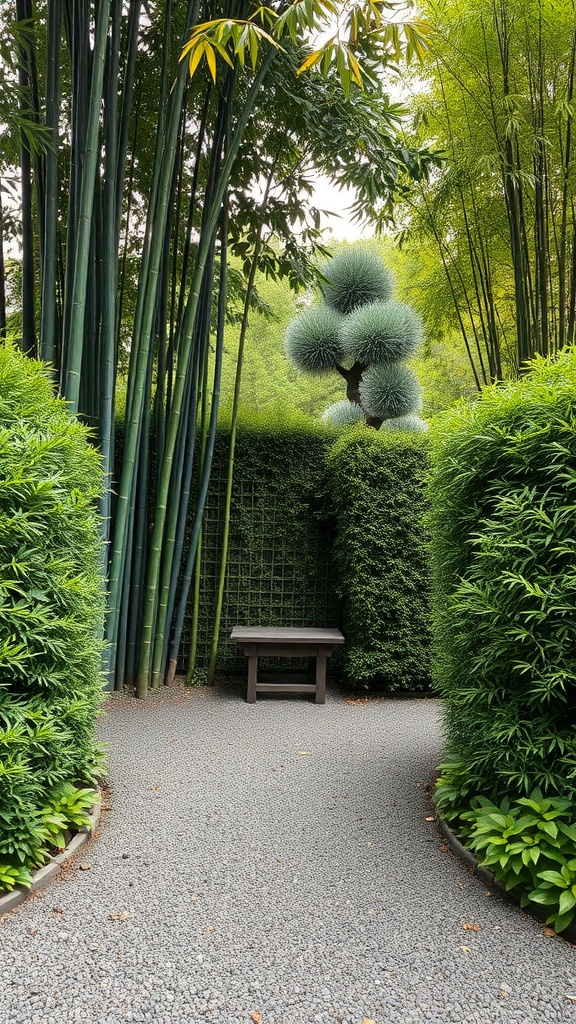
In a Japanese garden, privacy is often achieved through natural barriers. The image shows a serene pathway surrounded by lush greenery, which creates a sense of seclusion. Tall bamboo stalks on one side and neatly trimmed hedges on the other form a cozy enclosure. This setup invites visitors to step into a peaceful retreat.
The use of plants like bamboo not only adds height but also enhances the overall aesthetic. Bamboo is known for its fast growth and dense foliage, making it an excellent choice for creating privacy. The rounded, sculpted tree in the center adds a unique focal point, breaking the monotony of straight lines.
Along the pathway, the gravel surface provides a gentle crunch underfoot, adding to the sensory experience. A simple wooden bench offers a perfect spot to sit and enjoy the tranquility. This design encourages relaxation and reflection, making it an ideal escape from the outside world.
Lighting Techniques for Evening Ambiance
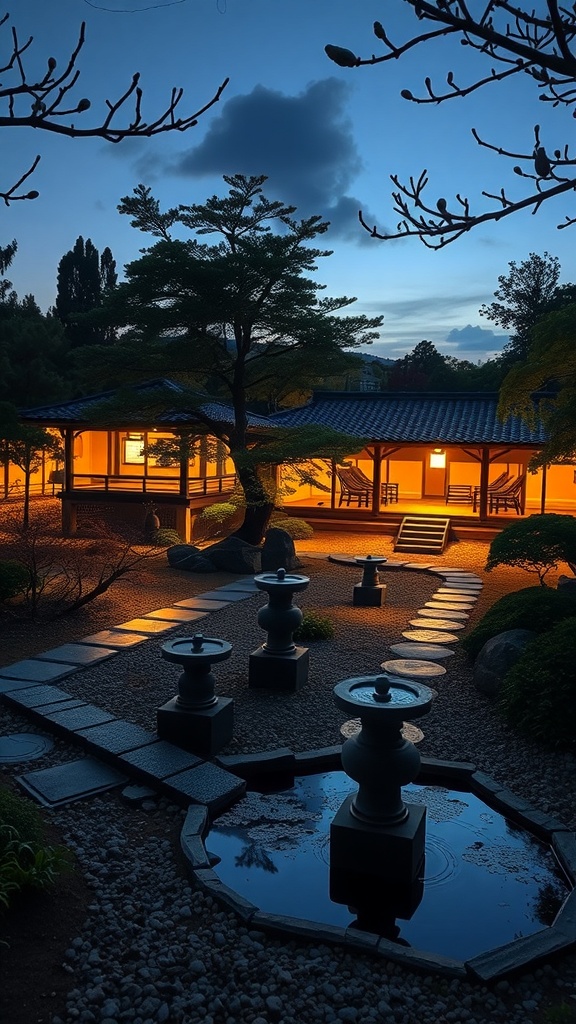
Creating a serene atmosphere in a Japanese garden during the evening can be a delightful experience. The image beautifully showcases how lighting transforms the space. Soft, warm lights illuminate the traditional structures, casting a gentle glow that invites relaxation.
The carefully placed lanterns along the path add charm and guide visitors through the garden. Their subtle light reflects off the water features, enhancing the tranquil vibe. This kind of lighting not only highlights the beauty of the garden but also creates a peaceful retreat from the outside world.
Incorporating different light sources, like lanterns and spotlights, can help emphasize various elements of the garden. For instance, spotlighting a unique tree or a stone feature can draw attention and create focal points. Overall, thoughtful lighting choices can make evening strolls in a Japanese garden truly magical.
The Importance of Focal Points in Design
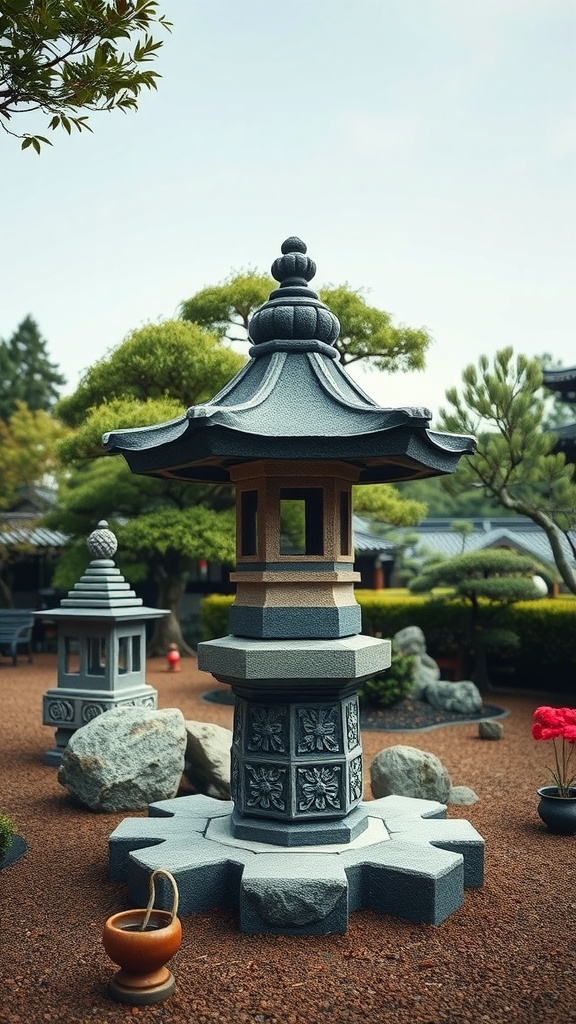
In a Japanese garden, focal points play a key role in guiding the viewer’s eye and creating a sense of harmony. The image showcases a beautifully crafted lantern, which serves as a striking centerpiece. This lantern not only adds visual interest but also embodies the traditional aesthetics of Japanese design.
Focal points like this lantern can draw attention and encourage exploration of the surrounding elements. The carefully arranged stones and lush greenery enhance the overall experience, inviting visitors to pause and appreciate the details. Each element works together to create a balanced scene.
When designing a garden, it’s essential to think about how these focal points interact with the space. They can be natural features, like a pond or a tree, or man-made structures, like the lantern in the image. Both types can evoke feelings of tranquility and connection to nature.
Incorporating focal points effectively can transform a simple garden into a serene retreat. They help to create a narrative, guiding visitors through the space and encouraging them to take in the beauty around them.
Seasonal Changes and Their Impact on Design
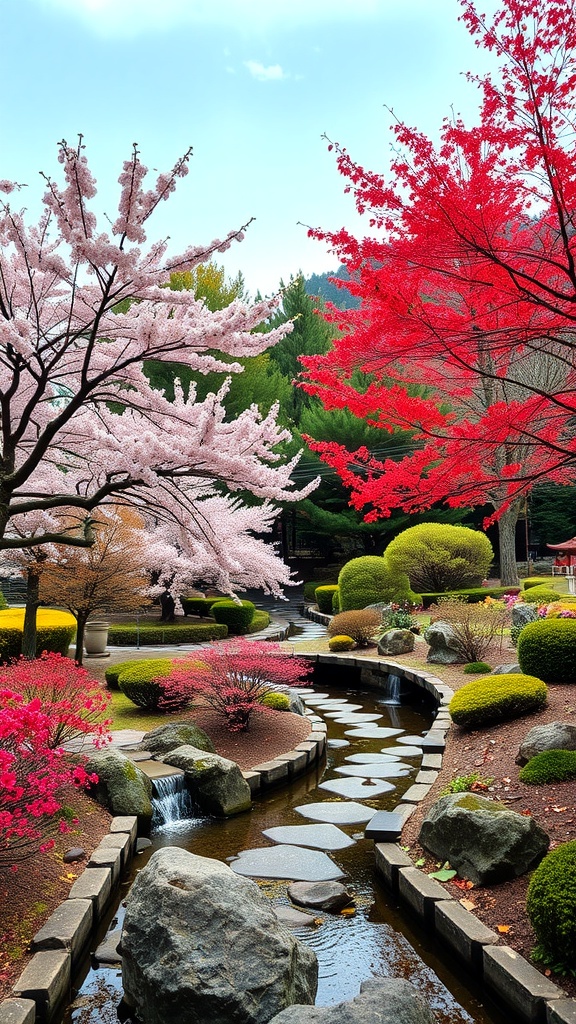
Japanese gardens are a stunning blend of nature and design, and they change beautifully with the seasons. In spring, cherry blossoms burst into bloom, painting the landscape in soft pinks. This vibrant display invites visitors to enjoy the fleeting beauty of nature.
As summer rolls in, lush greenery takes center stage. The garden transforms into a cool retreat, with dense foliage providing shade. This season encourages relaxation and contemplation, making it a perfect time for quiet reflection.
When autumn arrives, the garden showcases fiery reds and oranges. Maples and other trees put on a spectacular show, creating a warm and inviting atmosphere. This seasonal shift reminds us of the beauty of change and the cycle of life.
Winter brings a serene stillness. The garden, often blanketed in snow, offers a peaceful escape. The stark beauty of bare branches and the crisp air create a different kind of charm, inviting visitors to appreciate the quiet moments.
Each season brings its own character, influencing the design and experience of the garden. By embracing these changes, Japanese gardens become a living art form, reflecting the beauty of nature throughout the year.
Sustainable Practices in Japanese Garden Maintenance
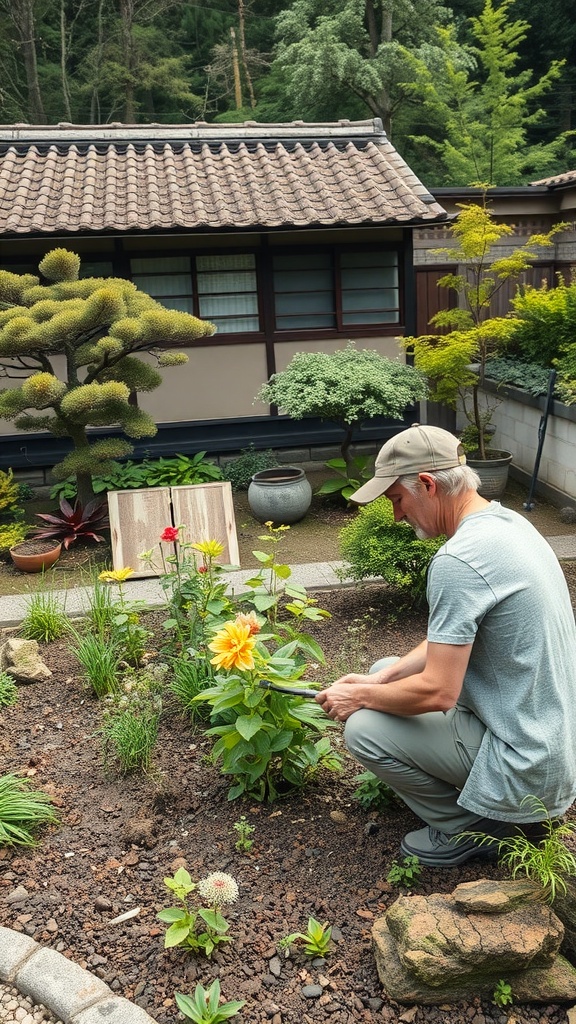
Maintaining a Japanese garden involves thoughtful practices that respect nature. In the image, we see a person tending to a vibrant flower bed, showcasing the hands-on approach typical in these gardens. This care not only keeps the garden beautiful but also supports local ecosystems.
One key practice is using organic methods for pest control. This means avoiding harsh chemicals and instead opting for natural solutions. For instance, introducing beneficial insects can help manage pests without harming the plants.
Another important aspect is water conservation. Japanese gardens often feature elements like ponds and streams, but they also incorporate techniques to minimize water use. Collecting rainwater and using mulch can help keep the soil moist while reducing waste.
Plant selection is also crucial. Choosing native plants that thrive in the local climate can reduce the need for extra care and resources. This creates a garden that is not only sustainable but also in harmony with its surroundings.
Finally, regular maintenance, like pruning and weeding, is essential. This keeps the garden healthy and allows for the natural beauty to shine through. The person in the image is actively engaged in this process, reflecting the dedication required for a sustainable Japanese garden.
